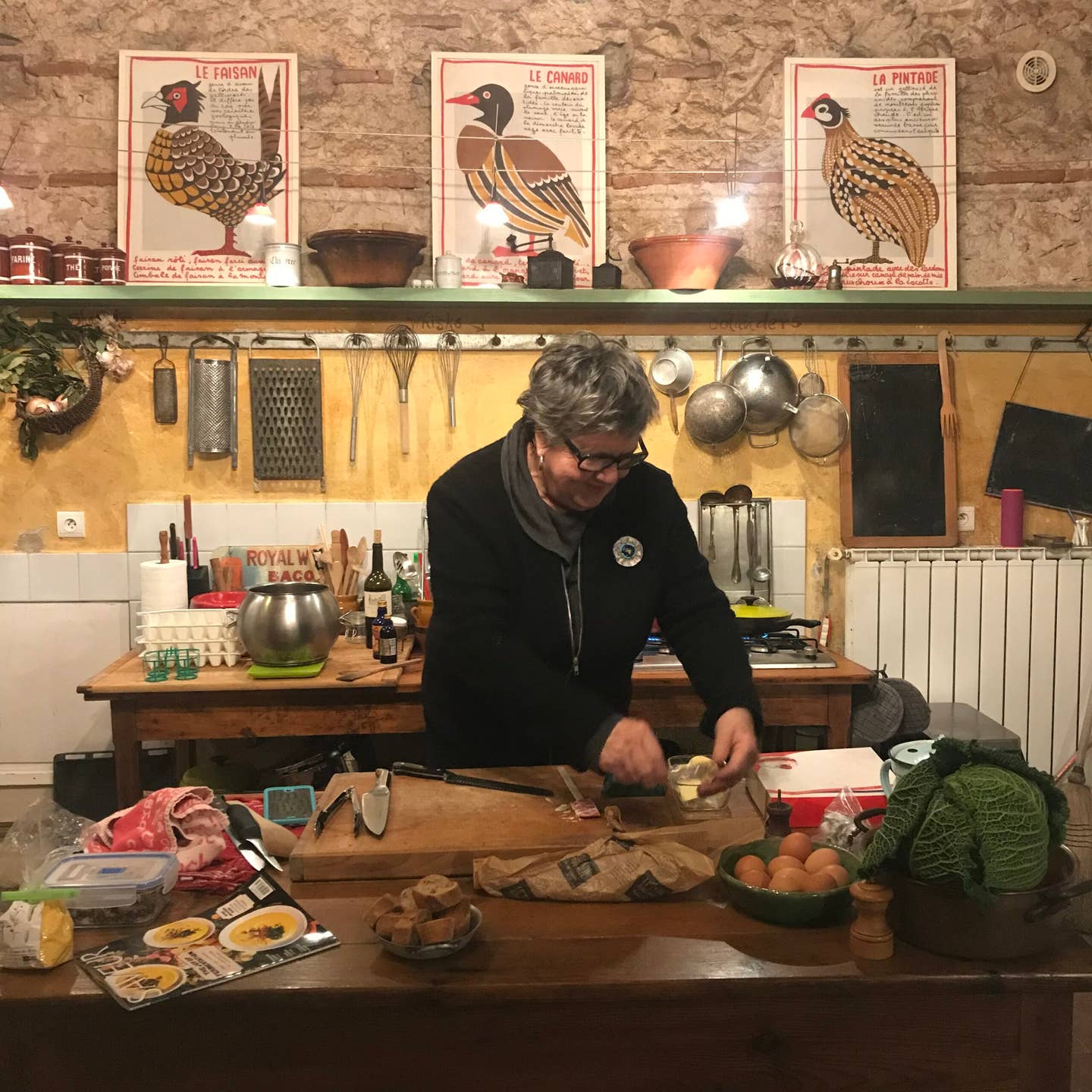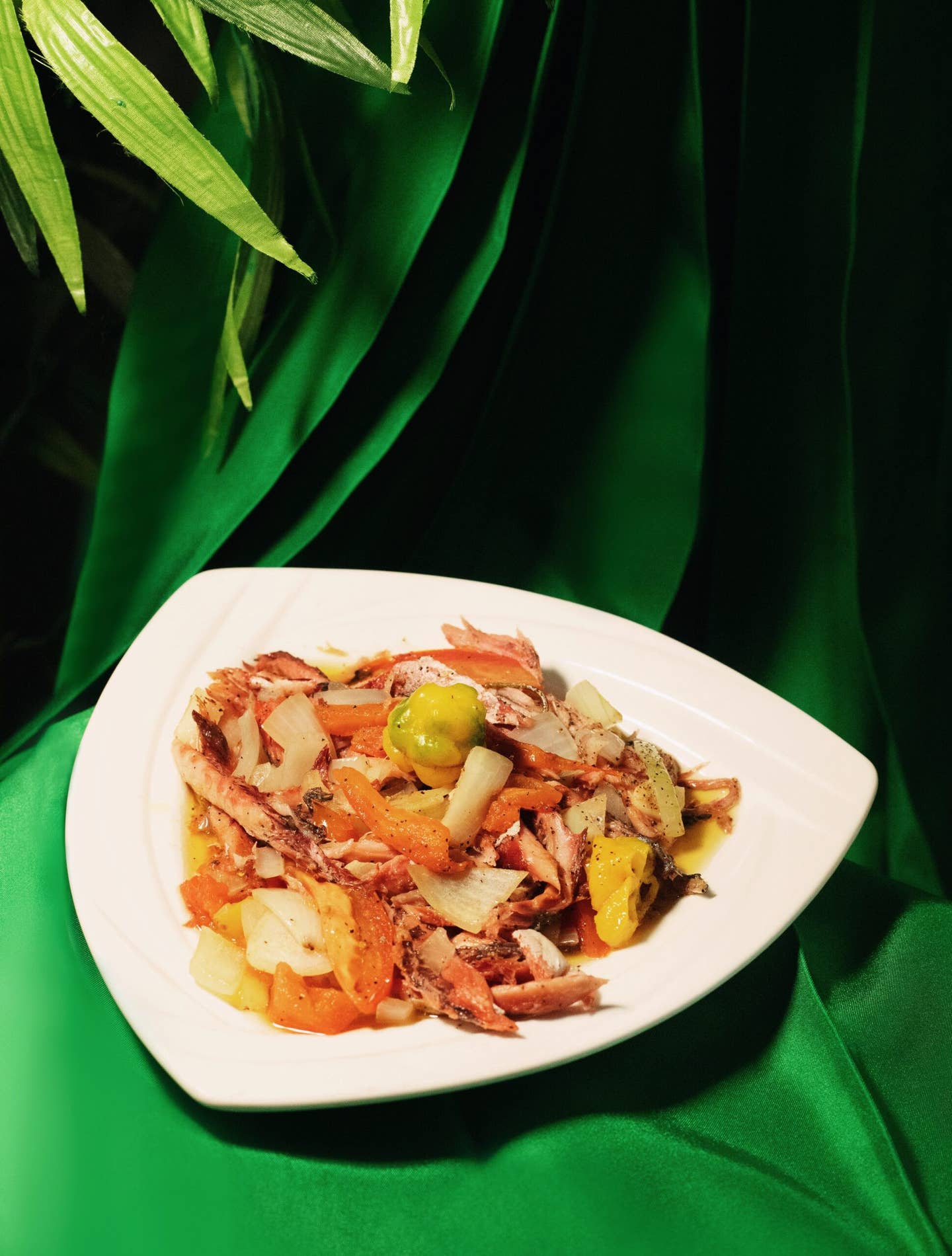
How Learning to Butcher in France Made Me Rediscover Myself
Meat and mentorship with the pioneer of seed-to-sausage charcuterie.
Today I’m breaking down a whole pork shoulder. I procured the meat from a pig farmer operating in the Willamette Valley, near my home in Portland, Oregon. With my boning knife, I separate trotter from hock, hock from picnic, picnic from coppa. I’ll use bones and skin for stock, hock for salting and smoking, coppa for curing and drying, the rest of the shoulder for sausage, and there will be just enough leftover meat and fat to make rillettes. I repeat the French names in my head: pied, jarret, palette, echine. This ritual is my modern translation of a centuries-old peasant tradition—and as close to worship as my atheist bones will ever get.
In 2009, having just lost my job as a magazine editor and ended a relationship with the man I thought I would marry, I reached out to the American cook and instructor Kate Hill, whom I’d met when she passed through Portland a few years prior to teach a class on Gascon cooking. Kate’s Kitchen-at-Camont, an 18th century farmhouse in southwestern France, is situated on the banks of the Canal de Garonne. Her lush and welcoming culinary retreat and school has hosted hundreds of guests each year since she arrived in the 1990s. All those years ago, Kate learned the Gascon ways of duck fat and cassoulet, saucisson and ventreche. She befriended the butchers, bakers, and Armagnac-makers of Gascony—people who would also eventually become dear friends and mentors to Kate’s guests and students.
When we met in Portland, I imagined the Kitchen-at-Camont as a mythical haven for lost people like me. In our modern times, it’s so easy to forget where our sustenance comes from, and I was ready to reconnect. So I called her up.
“Can you teach me how to butcher a pig?” I asked.
“I know just the person,” she said.
In the cold salle de coupe, or cutting room, on the farm of Dominique Chapolard, Kate’s friend, pig farmer, and butcher, I not only studied the art of cutting up hogs. I also learned how to transform the entire animal into delicious, nourishing food. “If someone worked hard to raise this animal well,” Dominique taught me, “you should use every part.”
Here, on the vertically integrated pig farm that Dominique owns and operates with his wife, sister-in-law, and three brothers, I was educated, as Kate liked to say, “seed to sausage.” “It isn’t just about the cuts,” she told me, “It all starts with a well-raised pig.”
“Kate has a fantastic open-mindedness,” Dominique recently told me. “She took us out of our comfort zone by asking us to explain why we cut the pigs the way that we did, and why we cooked what we cooked. Then she asked us to teach our trade to others.”
Together, Dominique and Kate gradually built what he likes to call their “school without walls.” When I wasn’t in the cutting room, Kate marched me into local slaughterhouses, through market stalls, and even into her own kitchen, where she taught me to properly salt a ham.
Back then, I was only the second student to pass through Kate and Dominique’s doors, but right around the time I left, a butchery and charcuterie renaissance was afoot, both here in the United States and elsewhere. Hundreds more students would eventually follow me.
“We didn’t want to just teach butchery. We wanted to teach a way of life.”
Kate Hill and Dominique Chapolard
“We didn’t want to just teach butchery,” Kate and Dominique have both told me. “We wanted to teach a way of life.” And so they did. The Camont principles have spread far across the globe. High-profile figures have visited—among them writer and author Michael Ruhlman and pastry chef and Paris-based blogger David Lebovitz. Kate and Dominique have traveled to the States as well, to teach alongside chefs including Craig Diehl, of Charleston’s European-style butcher shop Artisan Meat Share, and Portland’s trailblazing restaurateur Vitaly Paley. However, the pair speaks most proudly about the countless unsung kitchen heroes and career changers who came to Camont with a vague idea—perhaps to start a pig farm, open a meat-focused restaurant, or launch a butcher shop—then returned home with a concrete plan and ample inspiration. “Take what you learn with us in France,” Kate always told her students, “and translate it to wherever you live.”
After Peruvian chef Renzo Garibaldi studied with Kate and Dominique, he returned to Lima and launched his renowned whole-animal butcher shop and restaurant, Osso, which combines the techniques he learned in Gascony with the flavors of Peru. Erika Lynch visited Kate and Dominique as a school teacher, but returned home a charcutière. Her company, Babette’s Table, now sources pork from Vermont farms and sells handmade, Kate-and-Dominique-inspired charcuterie all over the country. “I’m always trying to recreate the feeling I got sitting around their table,” Lynch says.
“They worked so hard,” recalls Charles Lee, who studied at Camont in 2015, before opening the American Pig, a wholesale charcuterie company in North Carolina. “But they always took so much care, and so much integrity.”
Our respective ways of life are always changing, of course. Dominique and his wife Cristiane recently retired, and the other Chapolard brothers aren’t keen to continue teaching. Kate recently published a new digital edition of her transportive 25-year-old cookbook, A Culinary Journey In Gascony. She hosted her last “Camp Charcuterie” in 2019; the COVID-19 pandemic has put a stop to her once nearly constant stream of international visitors. She doesn’t foresee hosting in-person classes anytime soon, but—ever scrappy and innovative with her mentorship—she has branched out to offer online classes, now live-streamed from her familiar farmhouse kitchen.
Back in my own Oregon kitchen, I’m finishing up a batch of Gascon-style pork rillettes, relishing the relative quiet—something I’m not used to. When I returned from Gascony, I launched two businesses, a butchery school called the Portland Meat Collective, and a national nonprofit, the Good Meat Project. Both aim to teach consumers, farmers, and food professionals the same basic tenets I learned all those years ago in France: how to transform an animal from seed to sausage with respect and care for the land, the animals, and the people who raise and eat them.
When I’m butchering during normal times, I’m usually surrounded by at least a dozen people with endless questions. These days, it’s often just me, and sometimes my three-year-old daughter, Djuna, asking “who killed that pig?” and “how?” and “why?” and “can I taste that?” Kate and Dominique inspired so many of us to ask those same questions, and now my daughter will carry those lessons with her throughout her life. Their legacy will make Djuna—as they did myself and so many others—an eater who doesn’t just take pleasure in the food on her plate, but also in the complex and nuanced story behind it.
Camas Davis is the founder of the Portland Meat Collective, a meat school and culinary resource in Oregon, as well as of the Good Meat Project, an initiative to facilitate responsible meat production and consumption. She is also the author of Killing It, a memoir about her adventures in the world of meat.
Keep Reading
Continue to Next Story










